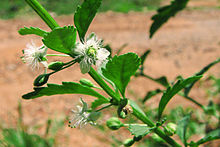Scoparia dulcis is a species of flowering plant in the plantain family. Common names include licorice weed,[2] goatweed,[3] scoparia-weed and sweet-broom in English, tapeiçava, tapixaba, and vassourinha in Portuguese, escobillo in Spanish, and tipychä kuratu in Guarani.[4] It is native to the Neotropics but it can be found throughout the tropical and subtropical world.[4]
| Scoparia dulcis | |
|---|---|
 | |
| Scientific classification | |
| Kingdom: | Plantae |
| Clade: | Tracheophytes |
| Clade: | Angiosperms |
| Clade: | Eudicots |
| Clade: | Asterids |
| Order: | Lamiales |
| Family: | Plantaginaceae |
| Genus: | Scoparia |
| Species: | S. dulcis |
| Binomial name | |
| Scoparia dulcis | |
| Synonyms[1] | |
| |

Although S. dulcis is considered a weed in many parts of India and Bangladesh, its use in traditional medicine has led to overexploitation.[5] The plant is also found as a weed in American citrus groves.[3]
Traditional medicine
As a traditional medicine, S. dulcis has been used for diabetes in India and hypertension in Taiwan.[6] In Siddha medicine it is used for treatment of kidney stones, but it needs rigorous diet method. It is called kallurukki (stone melter) in Malayalam and Tamil. In Brazil, it has been used for various problems such as hemorrhoids and wounds.[7]
Chemical constituents
Chemicals that have been isolated from S. dulcis include scoparinol[8] and epinephrine.[9][10]
Gallery
- Flower of Scoparia dulcis
- Scoparia dulcis, near F.Cl. de Patako, Senegal
- Flower of Scoparia dulcis
- Scoparia dulcis
- New leaves of Scoparia dulcis
- Scoparia dulcis plant
References
External links
 Media related to Scoparia dulcis at Wikimedia Commons
Media related to Scoparia dulcis at Wikimedia Commons- Scoparia dulcis in West African plants – A Photo Guide.






